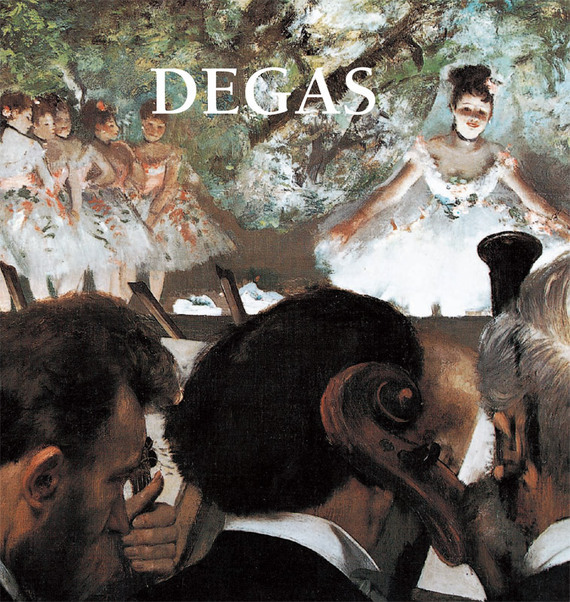Электронная книга: Nathalia Brodskaya «Degas»

|
Серия: "Perfect Square" Degas was closest to Renoir in the impressionist’s circle, for both favoured the animated Parisian life of their day as a motif in their paintings. Degas did not attend Gleyre’s studio; most likely he first met the future impressionists at the Caf? Guerbois. He started his apprenticeship in 1853 at the studio of Louis-Ernest Barrias and, beginning in 1854, studied under Louis Lamothe, who revered Ingres above all others, and transmitted his adoration for this master to Edgar Degas. Starting in 1854 Degas travelled frequently to Italy: first to Naples, where he made the acquaintance of his numerous cousins, and then to Rome and Florence,where he copied tirelessly from the Old Masters. His drawings and sketches already revealed very clear preferences: Raphael, Leonardo da Vinci, Michelangelo, and Mantegna, but also Benozzo Gozzoli, Ghirlandaio, Titian, Fra Angelico, Uccello, and Botticelli. During the 1860s and 1870s he became a painter of racecourses, horses and jockeys. His fabulous painter’s memory retained the particularities of movement of horses wherever he saw them. After his first rather complex compositions depicting racecourses, Degas learned the art of translating the nobility and elegance of horses, their nervous movements, and the formal beauty of their musculature. Around the middle of the 1860s Degas made yet another discovery. In 1866 he painted his first composition with ballet as a subject, Mademoiselle Fiocre dans le ballet de la Source (Mademoiselle Fiocre in the Ballet‘The Spring’) (New York, Brooklyn Museum). Degas had always been a devotee of the theatre, but from now on it would become more and more the focus of his art. Degas’ first painting devoted solely to the ballet was Le Foyer de la danse ? l’Op?ra de la rue Le Peletier (The Dancing Anteroom at the Opera onRue Le Peletier) (Paris, Mus?e d’Orsay). In a carefully constructed composition, with groups of figures balancing one another to the left and the right, each ballet dancer is involved in her own activity, each one is moving in a separate manner from the others. Extended observation and an immensenumber of sketches were essential to executing such a task. This is why Degas moved from the theatre on to the rehearsal halls, where the dancers practised and took their lessons. This was how Degas arrived at the second sphere of that immediate, everyday life that was to interest him. The ballet would remain his passion until the end of his days. Издательство: "Parkstone International Publishing"
ISBN: 978-1-78160-597-4 электронная книга |
Другие книги автора:
| Книга | Описание | Год | Цена | Тип книги |
|---|---|---|---|---|
| Cassatt | Mary est nee a Pittsburgh. Son pere etait un banquier tres liberal en matiere d'education, et toute la famille semblait manifester une certaine sympathie pour la culture francaise. Mary n'avait pas… — Sirrocco Publishing, (формат: 145x160, 256 стр.) Подробнее... | бумажная книга |
См. также в других словарях:
DEGAS (E.) — Il est délicat de cerner la personnalité artistique de Degas. S’il prolonge le respect ingresque de la ligne, il refuse la vénération plastique de la forme: ses exigences de véracité l’éloignent des canons de l’école. Ce n’est pas non plus au… … Encyclopédie Universelle
Degas — Cette page d’homonymie répertorie les différents sujets et articles partageant un même nom. Edgar Degas (1834 1917), peintre, graveur, sculpteur et photographe français. Degas, cratère sur Mercure. Ce document provient de « Degas ». Catégorie :… … Wikipédia en Français
Degas — Degas, Edgar, franz. Maler, geb. 19. Juli 1834 in Paris, war Schüler von Lamothe und seit 1855 der Ecole des Beaux Arts und malte zuerst historische Genrebilder, wandte sich aber bald der Schilderung des modernen Lebens zu. wobei er sich fast… … Meyers Großes Konversations-Lexikon
Degas — [də ga], Hilaire Germain Edgar, eigentlich H. G. E. de Gas, französischer Maler, Grafiker und Plastiker, * Paris 19. 7. 1834, ✝ ebenda 27. 9. 1917; zunächst Jurist, studierte ab 1855 Malerei. Die stärksten Anregungen verdankte er den Bildern J … Universal-Lexikon
degas — s. m. 2 núm. 1. [Brasil, Informal] Rapaz. 2. Pessoa que fala. 3. [Brasil: Sul] Eu (maneira de alguém se referir à própria pessoa.): o degas não vai (eu não vou). 4. Sujeito importante; contador de vantagens … Dicionário da Língua Portuguesa
Degas — Degas, Edgar … Enciclopedia Universal
